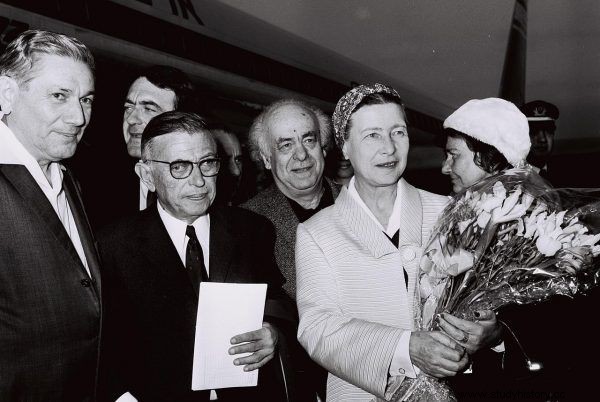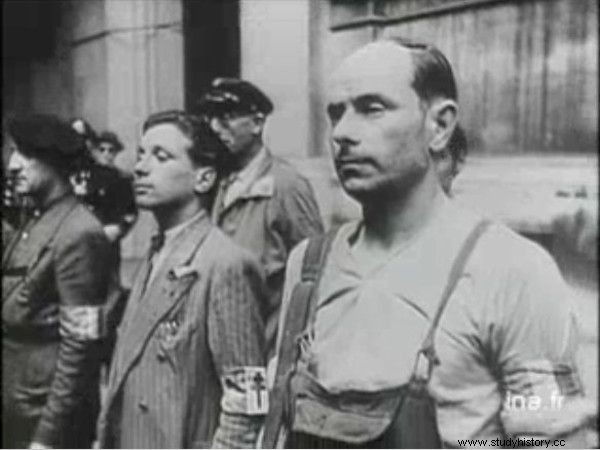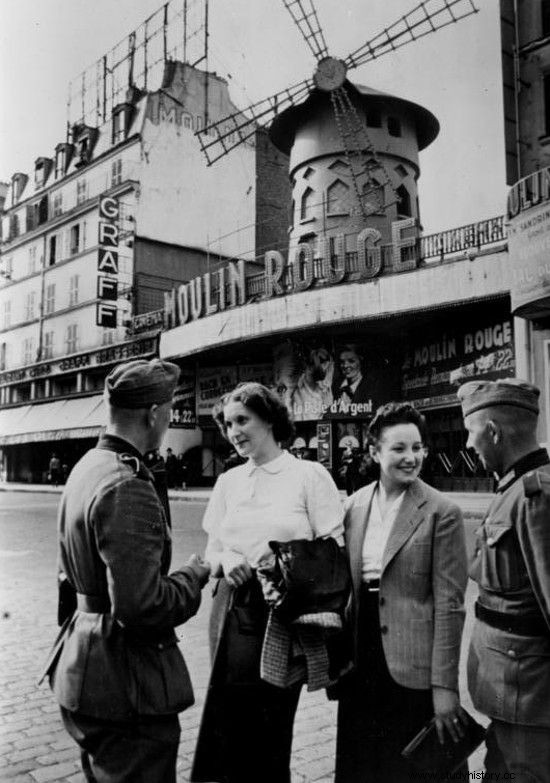British airmen dressed as onion sellers, radio hidden in a potty and partisans in obligatory black berets - that's the British comedy series. And reality? Mushrooms served to the Nazis instead of truffles and sabotage the elevator at the Eiffel Tower. And this is supposed to be the famous La Resistance?
After the rapid surrender of Paris and the humiliation inflicted on the power of France by Hitler, it was expected that the citizens, disappointed by the attitude of the authorities, would take the country's honor into their own hands. Strangely enough, it happened otherwise.
The French adapted relatively quickly to the new situation. Especially in the "free" zone, that is, managed by the Vichy puppet government. In the occupied part of France, i.e. in Paris, among others, the presence of the Nazis turned out to be "tolerable" for the French .
The intellectuals who have traditionally formed the backbone of freedom movements have remained largely neutral in France, if not in favor of the Nazis. It is not without reason that it is said today that Jean Paul Sartre became a member of the Resistance at about the same time as the French police - ten days before liberation.

French intellectuals, such as Jean-Paul Sartre (wearing glasses), only got involved in the resistance movement at the last moment (photo:Moshe Milner; source:Government Press Office; license CC BY-SA 3.0).
A joke repeated years ago that the French underground was so secret that neither the French nor the Nazis knew about it seems to be, at least until 1943, real. At that time, more than twenty-one underground organizations operated there. Most of them so small, badly organized, and with no ammunition of any kind, it would be an abuse to talk about mini-diversion in their case.
It was not until May 27, 1943 that the National Council of the Resistance (CNR - Le Conseil National de la Resistance) was established, which - with varying results - tried to control dozens of more or less successful sabotage actions. Today, sources say that at the time the CNR was established, the French resistance had fewer than 40,000 people.

On Saturday afternoons in July, CBS Europa starts a series of meetings with the legendary Louis de Funès. First, the famous classic:"The Great Vagabond", which was the inspiration for this article. You will see it tomorrow, July 2nd at 4:40 pm!
Passive resistance
While the resistance movements in Poland, Yugoslavia, and even Greece did not shy away from violence and competed in search of ways to defeat the occupiers in battle, French warriors encouraged their citizens to be… passive.
Also in France there was a "recruitment" of workers to factories of the Third Reich . However, since the number of applicants was much lower than expected, draft lists for men of working age were soon introduced. This is where the role of the French underground began - resistance movements, from right-wing to communist ones, encouraged citizens to hide and failing to appear on the invader's call.

While other European guerrillas called for fighting, La Resistance urged citizens to be… passive. At least until ... Pictured:Resistance members during the 1944 Paris Uprising (source:public domain).
For those who feel the call to passive resistance, it should be remembered that this is how the uprising in Paris began when, during the celebration of Bastille Day in July 1944, the French National Front called the inhabitants of the capital to strike.
The tram drivers, postmen and gendarmes completely paralyzed the town and the discouraged and aware of the approach of the allies, the Germans handed Paris over to the partisans. Today, they call these events, not without a bite, the "August Resistance".
Visual tamper
The most bizarre action of the French underground will remain the one concerning the symbol of Paris - the Eiffel Tower, when the cables in the elevators were cut to ... prevent Adolf Hitler from reaching its top and admiring the views of Paris. To this day, some people tell stories that, undaunted by this fact, Hitler simply chose the stairs.

Disappointed, Hitler leaves the Eiffel Tower, scolding the cruel resistance movement ... In fact, the observation sabotage did not make a great impression on him. In the photo on the left of Hitler the sculptor Arno Breker, on the right architect Albert Speer (source:Bundesarchiv, license:CC BY-SA 3.0 de).
However, the truth is different - Hitler without much regret gave up this point of the trip . Visiting Paris, which - as he himself claimed - wanted to see as a child, it took him less than three hours. He was accompanied by Arno Breker, Paul Giesler and the main architect of the Third Reich - Albert Speer.
The elevators in the tower were not repaired until 1945, so that the Allies and Parisians could enjoy the sight of a free city "after years of heavy occupation". Malicious claims that preventing Hitler from visiting the tower was the only successful French diversionary action.
This article has more than one page. Please select another one below to continue reading.Attention! You are not on the first page of the article. If you want to read from the beginning click here.
To die of love
Before Jean Moulin, a true French hero, led the fighters for French independence, various groups competed in more or less ridiculous ways to make the life of the Nazis difficult . Paris, treated as a true paradise by German soldiers, had plenty of entertainment to offer. Among them were, of course, brothels.

For many Nazis, Paris was a city of love ... Partisans decided to take advantage of it. In the photo:German soldiers with ladies at the Moulin Rouge (source:Bundesarchiv, license:CC BY-SA 3.0 de).
The sexuality of the soldiers was the apple of Heinrich Himmler's eye, so he placed particular emphasis on the safety of sexual relations with French prostitutes. A network of specially supervised brothels was established, in which records and examinations of girls were meticulously carried out. Despite dozens of fortifications, one of the underground groups created a plan according to which the sabotage of the German army was to start with an alcove.
The action was aimed at infecting Nazi soldiers with venereal diseases - even a search for carriers who were also good patriots was started and the preparation of forged health records for them. It seems, however, that the plan was not implemented . When it comes to assessing the effectiveness of this bed-sabotage - it is hard to say how many soldiers fell victim to the "patriot" and how many fell victim to the uncontrollable lust.

On Saturday afternoons in July, CBS Europa starts a series of meetings with the legendary Louis de Funès. First, the famous classic:"The Great Vagabond", which was the inspiration for this article. You will see it tomorrow, July 2nd at 4:40 pm!
Loose-up
Although it sounds more like a joke, it turns out that the French resistance was also active in ... gastronomy. Since, as mentioned earlier, being stationed in France was extremely pleasant, also the sabotage operations had to be adapted to the conditions prevailing in the country.
The restaurant guerrillas were tasked with lowering the morale of the Nazi partying who, moreover, were often unable to distinguish a real product from a counterfeit one. Hence the idea to replace real champagne with cheap sparkling wines and serve mushrooms instead of truffles .
The fight against the occupant for food is nothing special, but when in Poland food ranks for flour were plucked by trickery, the French hid the truffle collections from the Germans.

The restaurateurs also decided to depress the occupant ... by giving him mushrooms instead of truffles! The photo shows Luftwaffe soldiers in a Parisian cafe (source:Bundesarchiv, license:CC BY-SA 3.0 de).
For years, the French attitude during the war aroused only disgust and a smile of pity. Many legends have arisen around her. The French uphold the myth of the brave Resistance, while the Europeans continue to reproach them for collaboration, joking that the Champs Elysees are surrounded by trees so that the Germans do not have to parade in full sun .
Regardless of everything, it should be remembered that the situation of France was incomparable to that of Poland. Both in terms of repression, threat and, more generally speaking, historical realities. As Dr. Jan Zamojski explained:
Underground activities were extremely foreign to the French tradition. A whole series of great mishaps resulted from the inability to adapt to underground conditions. Hence, tendencies to establish contacts with Poles as those who have great experience in the underground.

Partisans from Huelgoat (author:Moreau.henri, license:CC BY-SA 3.0).
Also due to the large presence of foreign underground activists, Robert Gildea makes the sad conclusion that instead of the term "French resistance", it should be said "resistance in France". However, this does not change the fact that CNR has carried out almost one hundred and fifty successful attacks on objects important from a military point of view throughout the country.
***
On Saturday afternoons in July, CBS Europa starts a series of meetings with one of the most famous comedians of all time - the legendary Louis de Funès. At the beginning, the famous classics:"The Great Vagabond", "A Wing or a Leg", "Gentlemen, Take Care of Your Wives", "Hanged on a Tree" and "Miser". The first movie in the series is tomorrow, July 2 at 4.40 pm!

